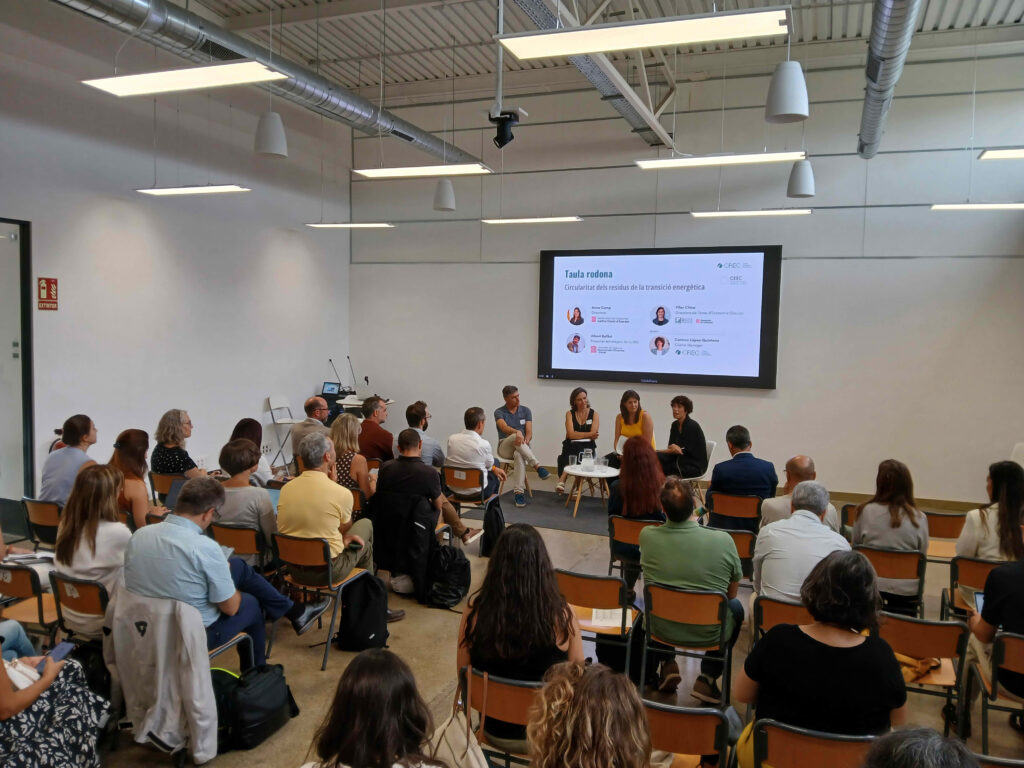-
Over sixty professionals gather at Barcelona Circular to address the decarbonization of the waste sector and the circularity of energy assets.
-
Companies such as CATOR, FCC Medioambiente, Molins, and Tandem HSE present best practices to reduce emissions, while calling for greater tax incentives from public administrations.
-
Catalan administrations warn of the lack of facilities to manage renewable waste and call for clear criteria for the circularity of energy-related waste.
The Catalonia Waste Cluster (CREC) and the Catalan Energy Efficiency Cluster (CEEC) organized an intercluster session this morning focused on addressing the decarbonization of the waste sector and the circularity of waste associated with the energy transition. The session, which brought together more than fifty people at the Barcelona Circular headquarters, served to connect both ecosystems and evaluate the challenges and opportunities that the circular economy offers to the energy and industrial sectors.
The session began with a presentation by Esther Izquierdo, Director of Innovation and People at WATTEGA, who urged all stakeholders in the energy value chain to move forward with strategies for the circularity of resources derived from the energy transition. “It’s no longer enough to think about their immediate use and benefit — we must consider what to do with these resources at the end of their useful life,” stated Izquierdo, emphasizing the role of circularity in achieving climate neutrality by 2050. She also highlighted the importance of circularity in the reindustrialization of Catalonia within the framework of the new European industrial strategy.
Next came a roundtable discussion moderated by CEEC Managing Director Francesc Ribera, focused on the challenges and opportunities of decarbonization in the waste sector. Panelists included Lluís Gimeno, Director of Circular Economy at CATOR; Pol Carreras, Head of Energy and Sustainability at Tandem HSE; Daniel Sanz, Head of Energy, Maintenance and Building Cleaning at FCC Medioambiente; and Manel Guillem, Head of Strategic Innovation and Business Development at MOLINS.
All participants agreed that regulatory changes and market competitiveness are the main drivers of industrial transformation towards decarbonization. They also reviewed some of the industrial-level solutions currently being implemented to move forward in emission reductions, and called on the public administration to provide greater economic incentives, such as tax deductions, for companies contributing to reducing their carbon footprint.
Following this first roundtable, the session continued with a second one focused on circularity in the energy transition. It was moderated by Carmen López-Quintana, cluster manager of the Catalonia Waste Cluster, and featured contributions from Anna Camp, Director of ICAEN; Pilar Chiva, Director of the Circular Economy Area at the Catalan Waste Agency; and Albert Ballbé, Head of Strategic Projects at the Directorate General of Industry.
Speakers addressed the challenge of managing waste associated with the growing number of renewable energy installations in the region. “We do not have sufficient facilities to manage the waste that will be generated in the coming years,” warned Chiva, stressing the need for “domestic capacity” to prevent these resources from being exported. Meanwhile, the ICAEN director called for greater ambition and the definition of criteria for managing energy transition assets, noting that while the law requires returning generation sites to their original state, “nothing is being done with what is being dismantled.” Finally, Ballbé emphasized the need for a “clear vision” of the desired direction, citing photovoltaic park management guidelines aimed at industrial decarbonization as an example.
The session concluded with remarks from CREC President Elisabet Alier, who highlighted the existing synergies between the energy and waste ecosystems. Alier pointed to the common needs of both clusters, identifying the challenge of waste decarbonization on one hand, and on the other, the commitment of energy transition stakeholders to circularity as a means to manage new waste streams.
